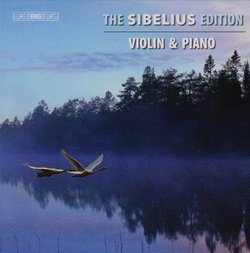| All Artists: Jean Sibelius, Folke Grasbeck, Bengt Forsberg Title: Sibelius: Violin & Piano Members Wishing: 0 Total Copies: 0 Label: Bis Original Release Date: 1/1/2008 Re-Release Date: 10/28/2008 Album Type: Import Genre: Classical Styles: Chamber Music, Forms & Genres, Concertos, Historical Periods, Classical (c.1770-1830), Instruments, Keyboard, Strings Number of Discs: 5 SwapaCD Credits: 5 UPCs: 675754011086, 7318591915171 |
Search - Jean Sibelius, Folke Grasbeck, Bengt Forsberg :: Sibelius: Violin & Piano
 | Jean Sibelius, Folke Grasbeck, Bengt Forsberg Sibelius: Violin & Piano Genre: Classical
|
Larger Image |
CD Details |
CD ReviewsFor diehard Sibelius fans and completists Michael Schell | www.schellsburg.com | 05/01/2010 (3 out of 5 stars) "Bis's formidable endeavor to record every surviving scrap from the pen of Finland's greatest composer continues with this Volume 6: five CDs devoted to Sibelius's music for violin and piano, with a few trifles for unaccompanied violin thrown in. I was surprised to learn that this particular combination of instruments could fill so many CDs. But the first two disks are mostly concerned with juvenilia (it's not until the last two tracks of CD 2 that we get the first piece with an opus number). A third CD is devoted to the composer's own reduction of BOTH versions of his violin concerto. And the fifth CD concludes with several "appendices" that cover alternate versions of works heard earlier, as well as the aforementioned unaccompanied violin pieces. This leaves slightly under two CDs' worth of original compositions for violin/piano from Sibelius's maturity.
Sibelius, of course, was a proficient violinist, who at one time dreamed of becoming a concert soloist. That never materialized, but the experience must have informed the massive amount of chamber music he wrote for the instrument in his youth. Much of this was written for him to play with friends and relatives, and is captured here and in Volume 2. Despite the violin infatuation, though, very few of the pre-opus number works on these first two CDs are compelling. Most fail to reach the level of invention of the best piano and large chamber pieces from Sibelius's apprentice years. Of course, once Sibelius did find his characteristic voice, it came by way of orchestral music. And after the two Op. 2 pieces from 1891, the next original compositions for violin and piano did not come until World War One, during which time the flow of royalty payments from Sibelius's German publisher Breitkopf & Härtel was disrupted. To help make ends meet, he dashed off several miniatures for Finnish publishing houses, including the Opp. 77-81 pieces for violin and piano. These are worth a couple of hearings (something that I think is true of practically any piece of music), but I still think of them as occupying the composer's third rank. Perhaps the best of the lot is the Sonatina, Op. 80, whose third movement, with its rapid piano figuration in the upper register, reminds me of Ravel, specifically the Laideronnette movement from Mother Goose, written five years earlier. Sibelius contributed subsequent collections of this kind in 1924 (Op. 106) and 1929 (Op. 115 and 116), the latter being among his very last original compositions. These are rather more interesting than the WWI-era pieces, and a few of them, like Op. 116/1, manage to evoke the sound world of Tapiola and The Tempest. It's a telling testament to how much the economics of art music have been changed by mechanical reproduction and other factors that Carl Fischer could write to Sibelius in 1928 asking that he "compose works for piano, voice and piano and violin and piano...We have every reason to believe that this would be a very commercial proposition". Jaakko Kuusisto puts everything he has into the performances of the early pieces, joined by the ubiquitous Folke Gräsbeck, who was featured in Volume 4 and Volume 10. For the violin concerto transcription, Madoka Sato replaces Kuusisto. Hearing the violin concerto in reduction is interesting to a musician or music lover the same way that hearing Stravinsky's two piano reduction of The Rite of Spring is interesting as an insight into the thought process of a great composer. Pity we don't have a reduction of the Humoresques for violin and orchestra! Most of the mature works featured on CDs 4 and 5 are entrusted to Swedes Nils-Erik Sparf, who is mainly known as a Baroque specialist, and Bengt Forsbert. Their playing is sensitive enough, though Sparf seems to struggle with some of the trickier runs in Op. 115/4. Sparf and Forsbert also give the original version of the Op. 2 pieces, of which the second is particularly interesting, a "Perpetuum mobile" that was watered down into an "Epilogue" in the revised version. If you're a casual Sibelius fan, the music here that you're most likely to find interesting can be found on one or two standalone CDs. Sibelius: Music for Violin and Piano Vol.1 and Sibelius: Works for Violin & Piano have all the mature original works for this combination of instruments. On the other hand, if the price point is attractive, the five CDs included here might be a compelling purchase, since they're at least offered at a discount from the single-CD prices, and if you can find them available as MP3 downloads, they'll be still cheaper. As a confirmed Sibelius fan, I'm happy to have the opportunity to hear this music, and I expect that most who know what they're getting with this release will be satisfied with Bis's offering." |

 Track Listings (25) - Disc #1
Track Listings (25) - Disc #1